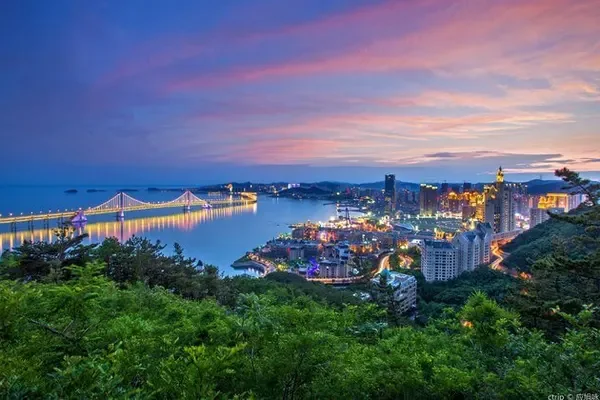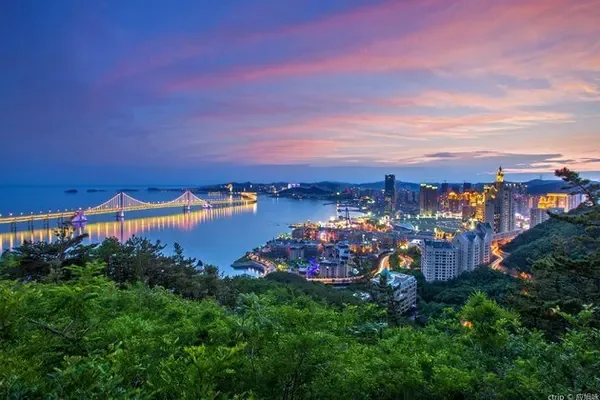I have been to all the four major municipalities directly under the central government in China, but only Tianjin has not had a good time. I have been to Tianjin many times before, and I hurried back after finishing business. This time, I happen to have time, energy and thoughts, so I will take a trip as soon as I say it.
After more than 600 years, Tianjin is full of unique urban features that combine Chinese and Western styles, ancient and modern.
This itinerary is scheduled for 4 days, mainly to see the city scenery, taste local delicacies, and have a relaxing leisure tour.
first day
At 1:30 in the afternoon, take the green leather car from Suzhou to Tianjin, with a soft sleeper.

Although it took more than 18 hours, the scenery along the way brought back childhood memories from time to time.

Passengers on the Nanjing platform

Passing the Nanjing Yangtze River Bridge



the next day
In the morning, the train stops at Jinghai Station, which was built in 1910 and passes through the Jinpu Railway. It is one of the top ten immovable cultural relics in Tianjin.

Arrive at Tianjin West Railway Station after 8:00,

Take the bus to Atour Hotel at Tianjin Railway Station, and start a new day after putting down your luggage.
The century clock is on the square at the entrance of the hotel. The century clock is a large-scale iconic city sculpture built in the square in front of Tianjin Railway Station in Tianjin to welcome the new century.

Jiefang Bridge is also one of the landmark buildings in Tianjin. It was originally built in 1902, rebuilt in 1923, and officially completed in 1927. The original name is "Wanguo Bridge", which means International Bridge. And this bridge is located at the entrance of the French Concession, and it was built under the auspices of the French Concession Industry Bureau, so Tianjin people preferred to call it the "French Bridge" at that time. After the victory of the Anti-Japanese War, the then national government named the bridge after Chiang Kai-shek, changing "Wanguo Bridge" to "Zhongzheng Bridge". In 1949, after the liberation of Tianjin, the bridge was officially renamed "Jiefang Bridge", and it is still in use today.
on the Liberation Bridge


Cross the Jiefang Bridge to Jiefang Road, with bank buildings on both sides.


The Porcelain House is a century-old French-style old building in Tianjin. It is decorated with tens of thousands of antique porcelain pieces and is one of the landmark buildings in Tianjin.


Arrive at "Five Avenues" at noon. Because it was once a British Concession, the buildings of various styles left over from various countries have become the brightest scenery.

Opposite is an elegant and quiet European-style building, which is now Maxim's French Restaurant.

I came to Guiyuan restaurant admiringly. In a half-old, unremarkable small western-style building, I ordered squid carp, Bazhen tofu, and chrysanthemum eggplant.



The Five Avenues Tourist Service Center and the Horse-drawn Carriage Station are located on Minyuan Square.
In the afternoon, take a carriage on the Five Avenues, and listen to the commentator's explanation while sightseeing, which is another feeling.











Xikai Church is the largest Catholic church in Tianjin, and the whole building is in French Romanesque style.



Nankai University was founded in 1919 by Mr. Zhang Boling, a famous patriotic educator and the alma mater of Premier Zhou Enlai.



Tianjin Ancient Culture Street, a national AAAAA-level tourist attraction, is one of the ten scenic spots in Tianjin.




I bought ear-eye fried cakes and collapsed beans on the street. . . . . .



The Haihe River is a river that runs through the urban area of Tianjin.

It is also a kind of enjoyment to board a boat to visit the Haihe River at night.

There are Jingang Bridge, Shizilin Bridge, Jintang Bridge, Bei'an Bridge, Jiefang Bridge, Chifeng Bridge, Daguangming Bridge, Liuzhuang Bridge and Guanghua Bridge on the Haihe River. Various high-rise buildings and more than 20 historical and cultural buildings stand on both sides of the Haihe River.


Tianjin Eye is located on the banks of the Hai River in Tianjin. It is a Ferris wheel built across the river and integrated with a bridge and a wheel. It is one of the landmarks of Tianjin.

third day
Yang Liuqing






Yangliuqing Town has a long history and profound cultural heritage. "Yangliu Qingnian Painting" makes people know Yangliuqing Town. In the town, there are the first private houses in North China - the Shijia Courtyard, the former site of the Tianjin Front Headquarters in the Pingjin Campaign, Yangliu Qingnian Painting and folk New Year painting workshops, etc.








Nanshi Food Street
One of the "Ten Views of Jinmen". There are hundreds of famous shops gathered on the street, which integrate various flavors: not only authentic famous Tianjin dishes and snacks, but also a collection of special dishes from all major cuisines in the country.

In the Tianjin restaurant, I ordered single gluten, crispy rice, pocket cakes and Heineken beer for a total of less than 100 yuan.
I bought mahua and other special products in Guishunzhai.


quiet garden
From July 1929 to November 1931, the last emperor Puyi lived here.




Tianjin Concert Hall

go five avenues


Chesslin Hotel

Qishilin Hotel is a well-known Western-style food restaurant, which was first built in 1901 and has a history of one hundred years.

You can experience the flavors of Germany, Russia, Britain, France, and Italy here. Today’s dinner is here. I ordered canned prawns, creamy mix, red cabbage soup, cheeselin potato salad, Tsingtao beer, etc. In fact, the most important thing is the environment, which makes people seem to travel back to the past.




Cheeselin cakes, chocolates, etc. are also very good.

fourth day
Atour Hotel walks to Italian Style Street.
Italian Style Street was originally the Italian Concession, and it is the largest Italian-style building complex outside Italy.


Former Italian Barracks

Former site of Catholic Sacred Heart Church

Liang Qichao Memorial Hall
Liang Qichao (1873-1929), courtesy name Zhuoru, was the owner of the drinking ice room. He is a famous thinker, statesman, social reformer and encyclopedic academic master in modern China. After returning from exile for 15 years in 1912, he settled in Tianjin in 1915.


Cao Kun's Former Residence
Cao Kun, the last great president of the Beiyang government.

The former site of the Italian Concession shop


The second floor is a public toilet


Former Residence of Yuan Shikai
Yuan Shikai was the leader of the Northern Warlords, the President of the Republic of China, and the Emperor of the Chinese Empire.

The victory of the People's Liberation Army at Jintang Bridge became the key to annihilating and defending the enemy, and Jintang Bridge became the starting point of Tianjin's new life.

Jintang Bridge is located on the Haihe River. The name of the bridge, Jintang, means "as solid as gold soup". It is one of the earliest existing large iron bridges in Tianjin.

Quanyechang

Quanyechang is an iconic representative of Tianjin's commerce. It is located at the junction of Heping Road and Binjiang Road. It was built in 1928. Tianjin Quanyechang was included in the "First Batch of Chinese 20th Century Architectural Heritage" list.

There are many snacks in Tianjin. Goubuli steamed buns and pancakes have been eaten for breakfast in the hotel. Taste other snacks here today, such as shrimp siu mai, red bean soup, sesame balls, etc.


A historical site on the way home

At 4:30 in the afternoon, I took the Fuxing High-speed Railway from Tianjin South Railway Station for 5 hours and returned to the warm Suzhou.




In just four days, the Green Leather Express, Fuxing High-speed Railway, subway, bus, taxi, horse-drawn carriage, cruise ship, Tianjin cuisine, Western food, Tianjin snacks, the time is not long, and the impression is unforgettable. If you are free, Tianjin is a big city worth seeing.

